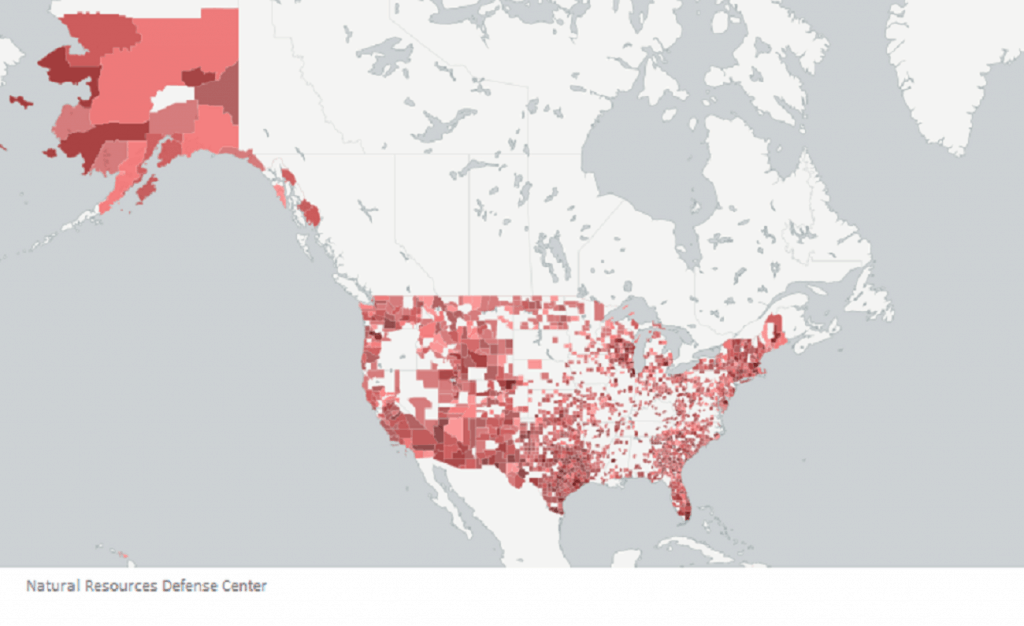 After the Flint Water Crisis began in April of 2014, the result of aging pipes leaking lead and heavy metals into the water supply, a major investigation was set in motion to test contaminated water sources all over the US. A report released yesterday by the Natural Resources Defense Council addressed the shortcomings in the Safe Drinking Water Act and the issues under the Lead and Copper Rule. In an analysis of EPA violation and enforcement records, the NRDC found that in 2015, 18 million people were using water systems with unresolved lead violations. They also believe that there is a serious problem with under-reporting, especially consider the city of Flint wasn’t even mentioned in any report, suggesting that the issue could be much larger than it appears.
After the Flint Water Crisis began in April of 2014, the result of aging pipes leaking lead and heavy metals into the water supply, a major investigation was set in motion to test contaminated water sources all over the US. A report released yesterday by the Natural Resources Defense Council addressed the shortcomings in the Safe Drinking Water Act and the issues under the Lead and Copper Rule. In an analysis of EPA violation and enforcement records, the NRDC found that in 2015, 18 million people were using water systems with unresolved lead violations. They also believe that there is a serious problem with under-reporting, especially consider the city of Flint wasn’t even mentioned in any report, suggesting that the issue could be much larger than it appears.
What’s So Dangerous about Lead?
Lead in the body is a solemn, dangerous poison. Once exposed, it is absorbed and distributed through the body the same way iron, calcium or zinc is. But unlike the helpful minerals, lead damages red blood cells and limits their ability to carry oxygen, causing anemia. If lead gets into the bone, it interferes with calcium production that’s used to strengthen not only bones and teeth, but muscle contraction, and nerve and blood vessel function. Prior to the 1970s, most lead poisonings transpired through lead paint and pipes, before the dangers of lead were realized. Today, as we see in Flint, the lack of proper infrastructure to replace old, lead-lined pipes can be fatal.
Your Area May Be Affected
The NRDC website provides an interactive map that allows you to see lead violations and which areas have been served more violations than others.

According to that same report, over 5,300 water systems are in violation and yet less than 1,000 of these cases have actually been addressed.
How Much Lead is Safe?
The Lead and Copper rule still allows for a legal toxic amount of lead in the drinking water. According to the EPA website, if “lead concentrations exceed an action level of 15 ppb or copper concentrations exceed an action level of 1.3 ppm in more than 10% of customer taps sampled, the system must undertake a number of additional actions to control corrosion”.
However, the Center for Disease Control and Prevention believes safe lead levels are much lower than the allowed amount. In fact, no safe blood to lead level has been identified. Even low levels of lead in blood have shown to affect IQ, the ability to pay attention and academic achievement in children. It is also impossible to reverse the effects of lead.
EPA regulations allow for fairly large margins of error before they send out violations, according to the above standards. If less than 10% of customer taps sampled, that’s not even the total amount of water taps in the area, show signs of unsafe lead levels, it still does not need to be reported for violation.
There are currently at least 4 million households with children living in them that are being exposed to high levels of lead. At least half a million children aged 1-5 have blood to lead levels above 5 µg/dL (which is 100ppb. The EPA tests taps if there is even as much as 15ppb).
What is Being Done
As CNN reports, former senior attorney in the EPA’s office of water enforcement Alan Morissey believes that addressing the problem would create more violations for the already under-resourced water department. “If you fix the problem of the game in the system, you now have hundreds – and thousands, perhaps – of municipalities that have direct violation”, he states.
But the EPA has acknowledged that it has “intensified work with state drinking water programs with a priority focus on the implementation of the rule,” the EPA regulator stated on the challenges of compliance with the lead and copper rule. They also go on to say that many of the water systems that were in violation in 2015 have resolved their issues, and a revised ruling will appear in 2017.
In the meantime, invest in water filters, be aware of the paint, pipes and soil if you live in an older home, and be aware of what you can do to minimize lead exposure in your house.
What are your thoughts? Please comment your thoughts below and share this news!
This article (Lead Contamination In Water Affects Over 18 Million People) is free and open source. You have permission to republish this article under a Creative Commons license with attribution to the author and TrueActivist.com


